I do like the idea of something like a 1960s le mans or can am car based around a space frame and some plastic panels!
It should be possible to come up with some reasonable geometry for the suspension though I can't get through the maths!
Caber


Greetings,
Been a while since I last posted... 'stuff' gets in the way sometimes.
Anyhow, been seriously considering getting back to the scratchbuilt midy project, from a new perspective. That is to say, a different powertrain. Yup,
you guessed it, Subaru in a 2WD config... most likely the EJ22.
Before I get all crossed up and make the wrong choice, I'd like to hear opinions on said powertrain. Pro's and con's if you will.
I expected width to be an issue, but my preliminary drawings suggest its a realistic hurdle. So lets ignore that for now.
Any thoughts?
Its interesting..
I was thinking just this the other day....But with the latest turbo jobby...
I guess you might be able to use a porsche gearbox if you turn it upsideown...
The engines are not actually 'that' wide...still a problem
quote:
Originally posted by tegwin
I was thinking just this the other day....But with the latest turbo jobby...
quote:
Originally posted by tegwin
I guess you might be able to use a porsche gearbox if you turn it upsideown...
you could use a 2dw box from the old front wheel drive models, not sure how strong the internals are on those.
you could however, make it 2 wd, basically bay welding up the centre diff.
see below.( itsays for rwd but i expect it will still work...maybe)
http://www.clubwrx.net/forums/showthread.php?t=27532&pp=20
The impreza Track is not as wide as you think, not as wide as a sierra.
i have a set up lying in the way in my garage.
plus..if i recall, someone is actually doing a middy Subaru project.
I have 3 friends, weel 2 and a brother with scoobies at tyhe moment, I am just waiting until one of them get written off so I can buy the salvage as a
donor. I was thinking similar put the engine and box at the back possibly even use the suspension or at least the uprights.
I do like the idea of something like a 1960s le mans or can am car based around a space frame and some plastic panels!
It should be possible to come up with some reasonable geometry for the suspension though I can't get through the maths!
Caber
quote:
Originally posted by meany
you could however, make it 2 wd, basically bay welding up the centre diff.
see below.( itsays for rwd but i expect it will still work...maybe)
http://www.clubwrx.net/forums/showthread.php?t=27532&pp=20
quote:
Originally posted by meany
The impreza Track is not as wide as you think, not as wide as a sierra.
quote:
Originally posted by meany
plus..if i recall, someone is actually doing a middy Subaru project.
if anyone wants any measurements, just ask. Im in my 5th year of scoob ownership.
the pics below are from a 96WRX.
and a legacy gearbox...same length.
its one long MoFo..lol.
http://s8.photobucket.com/albums/a33/meanandgreen/scooby%20bits%20for%20sale/
Here in California, Subaru STi drivetrains are very expensive, around US$10k, which is nuts.
quote:
Originally posted by kb58
Here in California, Subaru STi drivetrains are very expensive, around US$10k, which is nuts.
If I can get this thing to work, here are a couple of photos of 4WD and 2WD boxes, the 2Wd is a bit shorter (and lighter) but the rear mounts look to
be in the same place. One has cable clutch (2wd), the other hydraulic. Regards, Alan.

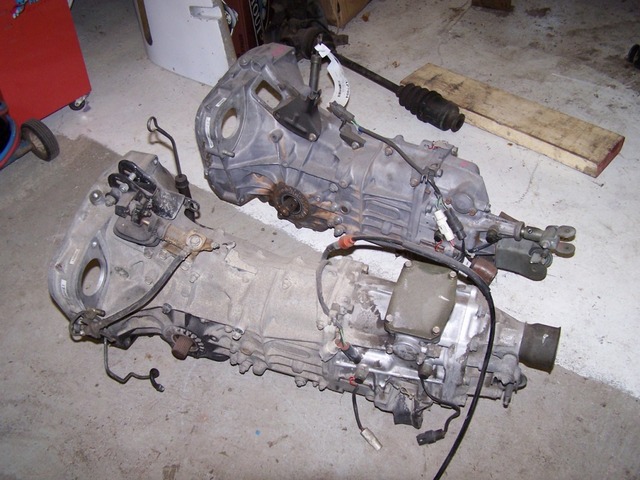
Rescued attachment 100_1334.jpg
And another
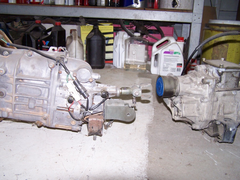

Rescued attachment 100_1332.jpg
And one more!


Rescued attachment 100_1324.jpg
http://www.constructorscarclub.org.nz/profiles/profile-brucetur.html
http://www.saker.co.nz

early 2wd and 4wd boxes are weak. Late model are good.
After seeing the Murtaya at the various shows this year I was really impressed with the Scooby engine - really compact and with a low CofG. Power
potential is good too - 400bhp+ is achievable without too much investment.
The Saker used the Legacy engine and box didn't it?
we were discussing using a boxer type engine on Pistonheads a couple of weeks back - after I started thinking about using the entire drivetrain from a
Boxster. By my reckoning the advantages in the lowered C of G and compactness of the engine make it a very worthwhile avenue.
a 911 turbo engine has been used in an Ultima, so width doesn't appear to be an issue - although triangulation of the chassis would appear more
difficult to start with, when you consider how shallow the whole engine can be you can carry out substantial triangulation above it, just make it bolt
in so the engine has an easy exit path.
Gator,
Thanks for the pics. What are the tranny designations for those, or what cars did they come from?
quote:
Originally posted by rpmagazine
early 2wd and 4wd boxes are weak. Late model are good.
quote:
Originally posted by CGILL
http://www.constructorscarclub.org.nz/profiles/profile-brucetur.html
http://www.saker.co.nz

quote:
Originally posted by Delinquent
a 911 turbo engine has been used in an Ultima, so width doesn't appear to be an issue - although triangulation of the chassis would appear more difficult to start with, when you consider how shallow the whole engine can be you can carry out substantial triangulation above it, just make it bolt in so the engine has an easy exit path.
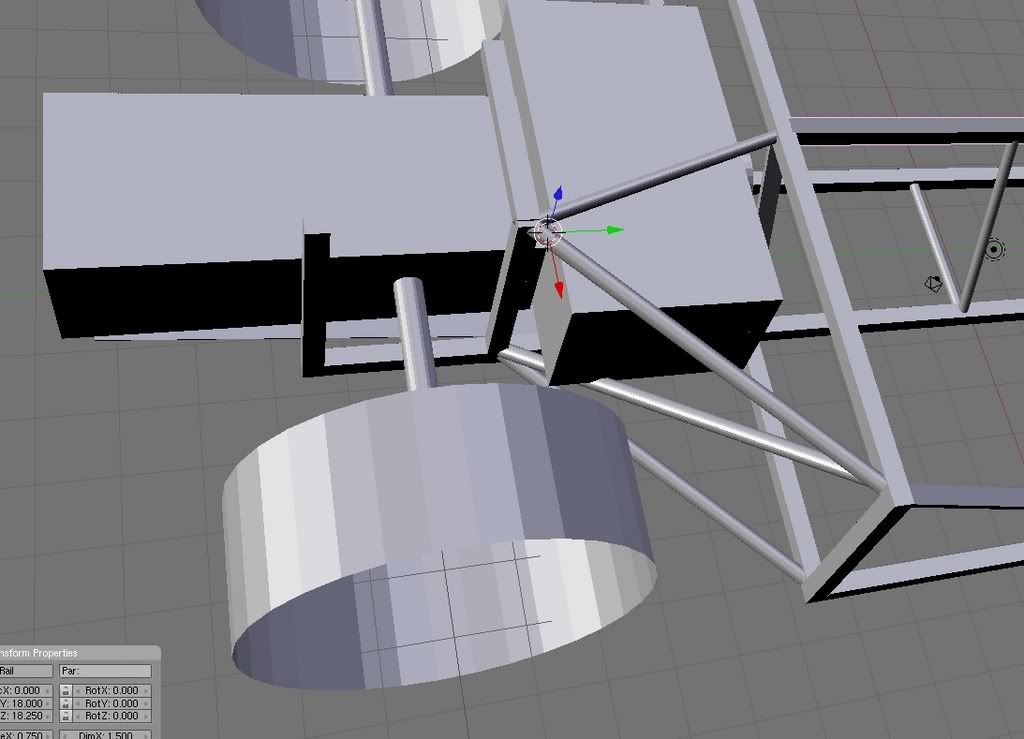
Hi there, the 4WD engine/box I have is from an import half cut Liberty EJ20T (single turbo) ref TY752VB1AA. The 2WD box ref TM752RH1AA was sourced separately. I assume it to be a Liberty prior to MY98 as Scoobies seem to be totally 4WD from about then. Regards, Alan.
Re COG of 'baru engine... don't be fooled, the crank location is much higher in the block than an I4, the centerline of the crank is also
the centerline of the main shaft of the box, the diff output is much lower than this, so for a clubman type car, either the engine needs to be located
high, or the axles run at large angles, most of the weight advantage is from an all aluminium block and heads, although the EJ is a hell of a lot
heaver than the early EA series engine. Honda B16 vtec engine and box are reasonably lighter 
Saker use FWD subaru box, some use 4wd with the guts chopped out and the tail capped, they are stronger. The hole in the center of the chassis for the
wide engine behind the wide driver cabin would need bolt in stress members I would say that can be removed for engine removal, the sound would be
awesome 
I don't know about the sound... The U.S. Subaru STi sounds just like a six-cylinder that has two spark plug wires pulled off. At least it sounds that way to me.
it depends on the exhaust manifold... a normal impreza wrx or STI usually runs a asymetric unequal length exhaust manifold which is not that good for
power but has a distinct burbly sound... a more powerfull japanese spec C model (used asa a basis for group N racing) has a symetric equal length
manifold that sounds really normal by comparison.. 
quote:
Originally posted by CGILL
Re COG of 'baru engine... don't be fooled, the crank location is much higher in the block than an I4, the centerline of the crank is also the centerline of the main shaft of the box, the diff output is much lower than this, so for a clubman type car, either the engine needs to be located high, or the axles run at large angles,
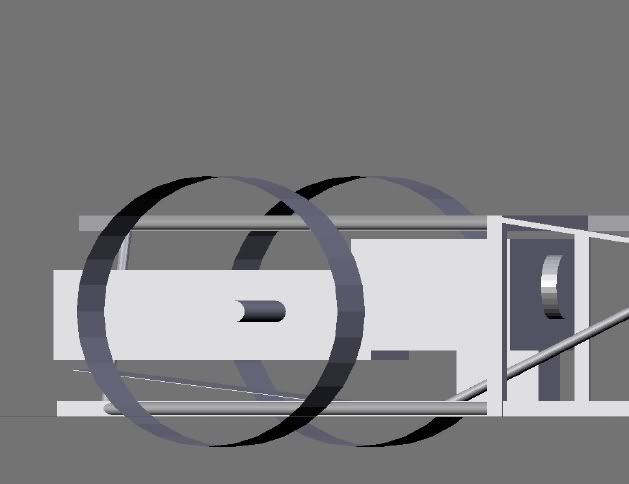
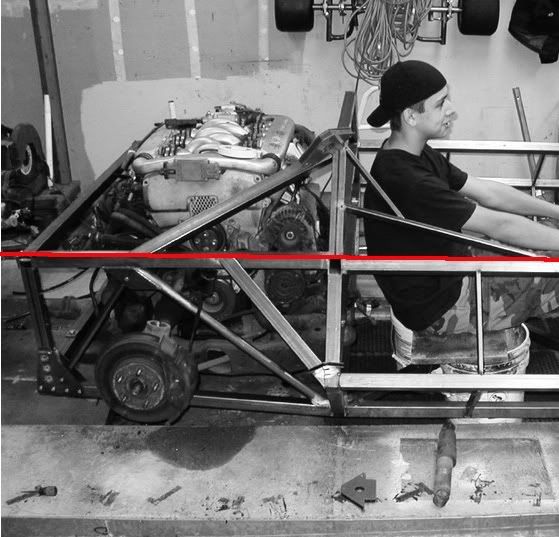
quote:
Originally posted by CGILL
most of the weight advantage is from an all aluminium block and heads, although the EJ is a hell of a lot heaver than the early EA series engine. Honda B16 vtec engine and box are reasonably lighter
The 6G75 3.8lt I am using weighs 275kg complete with transaxle, so it is no lightweight. The height of engine relative to driveshaft is partly set by approach/GC issues in FWD cars. However the transverse engines have an important asset in that the engine and transaxle can be rotated to lower the engine or the bell housing can be modified to achieve the same outcome. For me with the heavy V6 this means that the crankshaft can (with a lot of work) sit 40-50mm below that I could achieve with the Subie. However I have no idea of relative CoG heights overall.
Here's a rather cool Subbie-powered middie:
http://www.blastautomotive.com/
quote:
Originally posted by rpmagazine
However the transverse engines have an important asset in that the engine and transaxle can be rotated to lower the engine or the bell housing can be modified to achieve the same outcome.
quote:
Originally posted by kreb
Here's a rather cool Subbie-powered middie:
http://www.blastautomotive.com/
I think that he decided not to market it. He's a retired guy with money and probably didn't want the liability. I like the design though. Not particularly graceful, but well detailed, proportioned and fun looking. Almost buggyish..
quote:
Originally posted by rontyler
quote:
Originally posted by rpmagazine
However the transverse engines have an important asset in that the engine and transaxle can be rotated to lower the engine or the bell housing can be modified to achieve the same outcome.
Great point. As long as the lubrication is attended to... its an interesting thought... hmmmmmm....
quote:
Originally posted by rpmagazine
Not really original though as Lancia did oh so many years ago.
can anyone just confirm if there were any/ which subaru were 6 cyl / 2wd?
hi, the alfasud i'm modifying has the same issues as the subaru drivetrain ie heavy engine for the capacity relative to an equivalent inline 4,
high crank position relative to the bottom of the block and a transaxle with the output shafts below the mainshaft/ crankshaft line.
My latest plan is to fit a hewland mk 9 transaxle (basically an inverted beetle gearbox with a straight cut dog engagement gearset). This will allow
me to mount the engine about 75mm lower than the alfa box.
quote:
Originally posted by hughjinjin
hi, the alfasud i'm modifying has the same issues as the subaru drivetrain ie heavy engine for the capacity relative to an equivalent inline 4
Ron - you posted very nearly what I was going to. The Subbie 4 cyclinder engines are in the mid 200lb range and the stock output of the 2.5 liter is about 175 with abundant torque. So those engines are no slouches. The 6 cylinder engines are nice too - 230 to 270 HP but packa good deal more poundage (275 or so?)
quote:
Originally posted by kreb
Ron - you posted very nearly what I was going to. The Subbie 4 cyclinder engines are in the mid 200lb range and the stock output of the 2.5 liter is about 175 with abundant torque. So those engines are no slouches. The 6 cylinder engines are nice too - 230 to 270 HP but packa good deal more poundage (275 or so?)
Has anyone actually weighed these engines, or is it hearsay? Also, is that of the bare engine or complete? Without knowing what's included it
isn't very informative.
It's like the V8 argument that they hardly weigh any more than a four cylinder, yet it's of a shortblock! Until someone posts a picture of a
*complete* Subaru engine hanging from a digital scale, I'm skeptical. And we also must include transmission weight!
Engine weights seem to be about as reliable as people's golf score...
[Edited on 12/6/07 by kb58]
Kurt - your point is, of course valid. there are a variety of published weights for practically any engine. I'm still looking for that 400 pound
small block Ford! (Bare long block with aftermarket aluminum heads - maybie.) That said, I have seen mid 200s listed for Subaru H4s enough times to
feel pretty good about it.
Most of your DOHC vee engines are fairly large and porky. All that valvetrain adds up!
quote:
Originally posted by kb58
Has anyone actually weighed these engines, or is it hearsay? Also, is that of the bare engine or complete? Without knowing what's included it isn't very informative.
It's like the V8 argument that they hardly weigh any more than a four cylinder, yet it's of a shortblock! Until someone posts a picture of a *complete* Subaru engine hanging from a digital scale, I'm skeptical. And we also must include transmission weight!
Engine weights seem to be about as reliable as people's golf score...
[Edited on 12/6/07 by kb58]
Here's a data point: 1995 Honda H22A1, including complete engine with starter, alternator, flywheel, pullies, intake, header, tranny and axles.
475lbs. 190whp with only intake and exhaust.
If everyone posted with this detail we wouldn't have to guess engine and drivetrain weights.
So what's the entire Subaru drivetrain weight - all of it.
[Edited on 12/6/07 by kb58]
Kurt, I was really hoping you wouldn't take my post 'personally'. That wasn't the intent. It was more in 'jest'.
Peace?
If you read through this thread, top to bottom, I think you'll see that I've done my best to keep it factual and empirical, weeding out the
hearsay as much as practical.
quote:
Originally posted by kb58
Here's a data point: 1995 Honda H22A1, including complete engine with starter, alternator, flywheel, pullies, intake, header, tranny and axles. 475lbs. 190whp with only intake and exhaust.
quote:
Originally posted by kb58
So what's the entire Subaru drivetrain weight - all of it.
There's no way the a FWD 5mt weighs more than 200 lbs. I've moved many AWD 5mts alone, and many EJ engines, and an EA engine alone. Just
the short block of the EJ feels heavier. Yes I know this isn't real data, and the two are different shapes with different CoG's, but I
struggle at times with a shortblock, depending on what's still attached, whereas a tranny isn't THAT bad. I think someone somewhere posted
the weights, cant find it though.
FWIW a 4eat feels to weigh about the same as a block with one head and intake manifold still on. and 4eat's are much heavier than 5mts.
[Edited on 12/7/2007 by THAWA]
quote:
Originally posted by THAWA
There's no way the a FWD 5mt weighs more than 200 lbs. I've moved many AWD 5mts alone, and many EJ engines, and an EA engine alone. Just the short block of the EJ feels heavier. Yes I know this isn't real data, and the two are different shapes with different CoG's,
You got it.
some actual sizes of various engines would also be very helpful to build a decent database for those looking for something outside the ordinary - I have U2U'd Meany after his post early on in this thread but nothing back yet.
Hi there, I must keep the controversy raging. Using half of my incredibly expensive corner weight set, I would suggest that a 2WD scooby box (less
clutch fork etc) weighs in the order of 43kg. The 4WD box (with clutch fork) 57.5kg. Regards, Alan

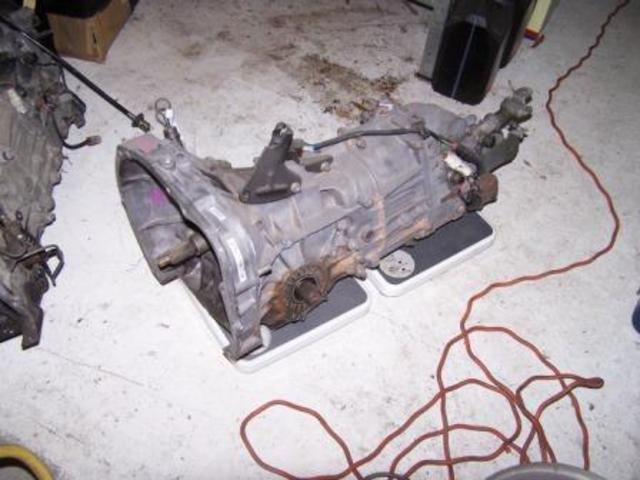
Rescued attachment 100_1582.jpg
The other view. Regards, Alan
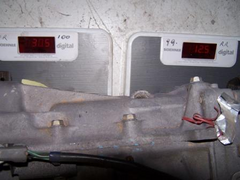

Rescued attachment 100_1586.jpg
quote:
Originally posted by gator
Using half of my incredibly expensive corner weight set, I would suggest that a 2WD scooby box (less clutch fork etc) weighs in the order of 43kg. The 4WD box (with clutch fork) 57.5kg. Regards, Alan
I think the Porker boxes are often flipped over without too much drama - at least the Ultima boys seem to get away with it.
quote:
Originally posted by rontyler
Outside of that 'little hurdle', anybody know of the consequences of running a transaxle upside-down?
Some thoughts on mounting the engines and CoG height.
First with a flat engine:
allow 4 inches under the car
allow 6 inches for the exhaust headers
asume the cylinder heads are 8 inches wide (so half this, 4, to the engine CL)
This gives 4+6+4=14 from ground to the crank CL
assume the input to output shaft distance for the gearbox is 3 inches and the Gbx is not inverted
the output shafts are therefore at 11 inches
for a normal tyre size for a non turbo 2.5 engine, say 225/45-15 at the rear and 195/50-15 at the front, the distance from the ground to the wheel
centres will be about 11.5 inches
So the axles will slope down by about half an inch from the hubs to the Gbx.
That all seems to work well. There are no extreme ground clearance or drive shaft angles to be concerned about.
The sump on the engine looks very deep so it may need cutting in the above example but a six inch deep sump isn't that extreme, unless someone is
about to put me right on this point!
scaling from a picture I found on Google it looks as if the top of the intake is about 14 inches above the crank which puts it at 28 inches
now for a straight four and inverted box
the lowest point on the whole assembly is now the bell housing so...
allow 4 inches to the bell housing
assume a further 7 inches to the crank
the crank CL is therefore at 11 inches above the ground.
for a wheel radius of 11.5 inches and an input output Gbx distance of 3 inches we have a drive shaft slope of 2.5 inches.
This seems a bit much given that permanent misalignment of over 7 degrees (a 1:8 slope) is considered a no no for CV joints. Note that I used the word
permanent there, I know that temporary much larger angles are no problem.
Assume that the top of the engine is 17 inches above the crank and this is at 28 inches.
This is exactly the same overall height as a flat four BUT the straight four has big cast bits such as the block and the head above the crank so the
CoG is higher.
Conclusion...
Use a flat engine with the Gbx the normal way up, the CoG is lower, the drive shaft angles are better, the overall height is the same and you
don't need to mess about with extra bits or mods to invert the box.
What about the Ultima set up?
lets assume 4 inches under the gearbox and a further 7.5 (assuming a slightly bigger housing than above) to the crank.
The crank is at 11.5.
The gearbox is inverted so the output shafts are at about 15 inches (again assuming a slightly bigger box than the above calcs)
The radius of the wheels is going to be about 13 inches (The ultima site gives two sizes, either side of this)
so the drive shafts slope 2 inches which puts them close to the maximum permanent slope of 7 degrees.
The height above the crank to the top of the block is about 15 inches so the overall height, excluding the intake, is going to be 26.5 inches.
Conclusion...
Inverting the box works when you have bigger tyres/wheels to keep ground clearance and drive shaft angles acceptable. The overall height isn't
far off a smaller straight four with an inverted box or flat engine with a box the normal way up.
[Edited on 15/12/07 by cymtriks]
it is a reasonable work through but fit to purpose becomes an issue. If you want to seriously use the vehicle on a track one of the first issues is
wheel/tyre availability. 15" wheels immediately limits your choice of brands and compounds in my market (note US/UK may be different).
You are also assuming no modification to components. With more modification the advantages are lessened or changed...but the Subie is limited in this
respect.
Having said that I think they are a very good thing, it's just that the picture is always more convoluted that we realise.
quote:
This is exactly the same overall height as a flat four BUT the straight four has big cast bits such as the block and the head above the crank so the CoG is higher.
A mesage for Del, I have accidentally deleted your Email address when clearing spam (Oh Bugger).
The dimensions you were after: O/all length 760mm; distance from leading edge of bellhousing to centerline of driveshaft approx 165mm. Hope this
helps, sorry for the stuffup.
Regards, Alan.
quote:
Originally posted by rpmagazine
it is a reasonable work through but fit to purpose becomes an issue. If you want to seriously use the vehicle on a track one of the first issues is wheel/tyre availability. 15" wheels immediately limits your choice of brands and compounds in my market (note US/UK may be different).
You are also assuming no modification to components. With more modification the advantages are lessened or changed...but the Subie is limited in this respect.
Having said that I think they are a very good thing, it's just that the picture is always more convoluted that we realise.
quote:
Originally posted by gator
A mesage for Del, I have accidentally deleted your Email address when clearing spam (Oh Bugger).
The dimensions you were after: O/all length 760mm; distance from leading edge of bellhousing to centerline of driveshaft approx 165mm. Hope this helps, sorry for the stuffup.
Regards, Alan.
 - when you say overall length, does that include the gearchange link (which I believe still pokes out the back of the 2WD
box?)
- when you say overall length, does that include the gearchange link (which I believe still pokes out the back of the 2WD
box?) quote:
Originally posted by kb58
quote:
This is exactly the same overall height as a flat four BUT the straight four has big cast bits such as the block and the head above the crank so the CoG is higher.
But then there's the accessaries. There's nowhere for the heavy alternator, starter, intake, and maybe turbo to go, except up above the engine. I agree that the CG will still lower than a I-4, but I suspect the advantage is less than expected; the CG certainly isn't at crank centerline. The flat-4's advantage is even smaller when compared to an I4 with an aluminum block and head.
quote:
Originally posted by cymtriks I'd guess that the CoG is about 2 iches above the crank.
CoG heights assuming the lowest mounting for each type-
Flat
4 inches for ground clearance, 6 for the exhaust and 4 for half the cylinder head gives a crank centre at 14 inches. The weight of the intake above
the crank is balanced by the weight of the exhaust and sump below it (though the sump will need cutting as it looks deeper than the exhaust as
standard). That leaves the effect of the remaining ancilliaries which raise the CoG to, as a guesstimate, 15 to 16 inches. The overall height is about
28 inches.
Straight
4 inches for ground clearance, 7.5 for the bell housing (the lowest point on the assembly, not the sump) gives a crank centre at 11.5 inches. The sump
is just a hollow box and the cylinders, head, intake and exhaust are all higher. While the crank is still the most massive bit the combined weight of
the intake, head and exhaust can't be far off and it is about 12 inches above the crank. So a guesstimate of the CoG would be about 15 to 16
inches. The overall height is about 28 inches.
So assuming you are not restricted by anything other than the engine there's no gain either way. The CoG is in about the same place and the
overall height is about the same.
BUT
In order to mount a flat engine at the height given above you can use the transaxle as it came and run low drive shaft angles. To do this with the
straight engine requires that you invert the box (cost and time to modify) and run higher driveshaft angles (possible long term reliability
issues).
Question-
Can the cheaper (not porsche G50 or Hewland!) boxes be inverted at reasonable cost?
Audi?
Renault?
Subaru?
For the home builder this might be the deciding factor.
I recently discovered that Volvo has an in-line transaxle, too.
Hi Kimini!
Do you mind telling what volvo has the in-line transaxle? Since I live in Sweden, this might be an attractive alternative to the Audi box for me
(availability of wrecked Volvos is pretty big here).
BR,
Ringius
quote:
Originally posted by Delinquent
quote:
Originally posted by gator
A mesage for Del, I have accidentally deleted your Email address when clearing spam (Oh Bugger).
The dimensions you were after: O/all length 760mm; distance from leading edge of bellhousing to centerline of driveshaft approx 165mm. Hope this helps, sorry for the stuffup.
Regards, Alan.
Many thanks Alan- when you say overall length, does that include the gearchange link (which I believe still pokes out the back of the 2WD box?)
Would be rather handy if it did, as it is a perfect fit within the bodyshell design at that size - would only require me to move the fwd mounts for the wishbones back - which is a point to note for anyone else considering this unit, the distance from the driveshaft centres to the back edge of the engine mean you're either going to have very short wishbones or the leading leg of the wishbone is going to be nearly perpendicular to the centreline.

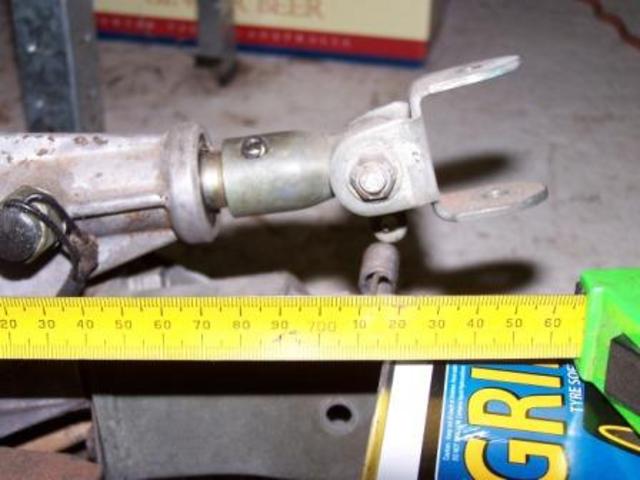
quote:
Originally posted by cymtriks
CoG heights assuming the lowest mounting for each type-
Flat
4 inches for ground clearance, 6 for the exhaust and 4 for half the cylinder head gives a crank centre at 14 inches. The weight of the intake above the crank is balanced by the weight of the exhaust and sump below it (though the sump will need cutting as it looks deeper than the exhaust as standard). That leaves the effect of the remaining ancilliaries which raise the CoG to, as a guesstimate, 15 to 16 inches. The overall height is about 28 inches.
Straight
4 inches for ground clearance, 7.5 for the bell housing (the lowest point on the assembly, not the sump) gives a crank centre at 11.5 inches. The sump is just a hollow box and the cylinders, head, intake and exhaust are all higher. While the crank is still the most massive bit the combined weight of the intake, head and exhaust can't be far off and it is about 12 inches above the crank. So a guesstimate of the CoG would be about 15 to 16 inches. The overall height is about 28 inches.
So assuming you are not restricted by anything other than the engine there's no gain either way. The CoG is in about the same place and the overall height is about the same.
BUT
In order to mount a flat engine at the height given above you can use the transaxle as it came and run low drive shaft angles. To do this with the straight engine requires that you invert the box (cost and time to modify) and run higher driveshaft angles (possible long term reliability issues).
Question-
Can the cheaper (not porsche G50 or Hewland!) boxes be inverted at reasonable cost?
Audi?
Renault?
Subaru?
For the home builder this might be the deciding factor.
quote:
Originally posted by gator
Hi, the 760mm includes the basic gearshift mechanism as shown, it's the most rearward part. I haven't given any thought to the arrangement of linkage(s) forward to the cockpit as yet.
Regards, Alan.

Am I missing something here? If one was to use a Subaru engine/gearbox, in a mid rear engined car, then the gearbox is already twirling the wheels
in the right direction. No need for flipping gearboxes because the Subaru motor is already ahead of the gearbox in the engine compartment. The
reason for flipping Porsche gearboxes is to get the mid rear engine to spin the wheels in the right direction due to the fact that the venerable 911
is rear engined. Also, using a 2WD box would definitely be the best solution as it would lack the components for 4WD output. have you ever
noticed how similar Subaru parts are to VW beetle pats ? 
I'm with you! I know someone who has the setup in a Porsche spyder replica. Seems OK to me despite the concerns most express on gearbox
weaknesses.
Regards, Alan
quote:
Originally posted by Benonymous
Am I missing something here? If one was to use a Subaru engine/gearbox, in a mid rear engined car, then the gearbox is already twirling the wheels in the right direction. No need for flipping gearboxes because the Subaru motor is already ahead of the gearbox in the engine compartment. The reason for flipping Porsche gearboxes is to get the mid rear engine to spin the wheels in the right direction due to the fact that the venerable 911 is rear engined. Also, using a 2WD box would definitely be the best solution as it would lack the components for 4WD output. have you ever noticed how similar Subaru parts are to VW beetle pats ?
Volvo has some FWD transaxles, oriented for north/south engines.
http://www.blastautomotive.com/photos.html
quote:
Originally posted by kb58
quote:
Originally posted by cymtriks I'd guess that the CoG is about 2 iches above the crank.
I would have thought that the in-lin CG would be lower, due to the heavy steel crank moving the CG to below half way up the block. I forgot about the CG effect of the intake assembly... I'm assuming an aluminum block and head, too. If both are steel, it's a lost argument for the inline.
While I'm not up on modified Subaru engines, I agree that aftermarket "go-fast" parts are much more widely available for inline engines. Just look in any car magazine and it's hard to find ads for Subie drivetrain parts.
All this stuff aside, the homebuilt car that a Subie will fit must have a really wide engine bay, and accomodate the long transaxle tail shaft. It would be a very different Locost, and not so low cost either. I recently saw a complete drivetrain from an STi... $10,000. That's crazy. Oh sure, there are Subi engines much cheaper, but they're the old ones that don't make much power.
[Edited on 12/17/07 by kb58]
I know this is an old thread but, the advantages of having the flat 4 suby is that almost all mechanical forces are balanced, including gearbox, and shafts. most i4's have a long and short driveshaft that creates torque steer in front wheel drives and tail happy middy's
quote:
Originally posted by Gakes
I know this is an old thread but, the advantages of having the flat 4 suby is that almost all mechanical forces are balanced, including gearbox, and shafts. most i4's have a long and short driveshaft that creates torque steer in front wheel drives and tail happy middy's
 ) and both of them are configured that way. And they're a lot more compact in plan than
a boxer layout.
) and both of them are configured that way. And they're a lot more compact in plan than
a boxer layout. Can someone please tell me the approximate size of the drivetrain:
1. How far forward of axle centerline is the front pulley of the engine?
2. How tall is the engine above the crankshaft, including all accessaries?
3. How wide is the engine, side-to-side, including any manifolds.
4. How far behind axle centerline does the transmission tail shaft extend?
Thanks!
I can't take credit for these so apologies to the person who originally uploaded them

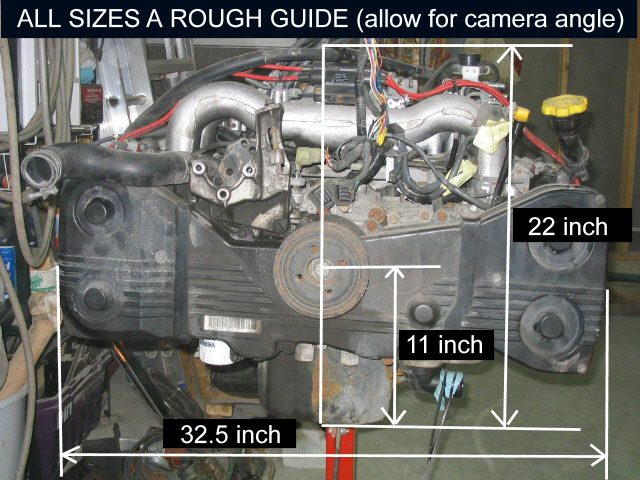
Rescued attachment imprezaenginesize.jpg
Any help? 


Rescued attachment imprezaenginedimensions.jpg
Very cool, thank you both!
quote:
Originally posted by kb58
Very cool, thank you both!
quote:
Originally posted by Gakes
I know this is an old thread but, the advantages of having the flat 4 suby is that almost all mechanical forces are balanced, including gearbox, and shafts. most i4's have a long and short driveshaft that creates torque steer in front wheel drives and tail happy middy's
quote:
Thawa
That's really not true. A boxer 4 still has imbalances, and any Subaru will torque steer given either enough torque, lack of grip, or shitty tires. Of course both of these cases will still be less than a 2wd inline 4, but they're still apparent in a boxer4, 2wd or awd.
 . There is much less torque steer on these powerplants, it is very noticeable with good tyres.
But it still does a little
. There is much less torque steer on these powerplants, it is very noticeable with good tyres.
But it still does a little
guys your horribly underestimating the subbies output , down here in the antipodes the EJ20t puts out 220 hp and with few minor mods 250-300 is easily
acheivable, for an instalation set up and specs Google Saker as they use the subby power train , and are designed and built by a good freind of mine
from just around the cnr,
plus i have just bought a chassis all set up with a EJ20t in it, some pics of said beast in my last post
cheers Kaspa
Here's what you can get if you go really silly with a Suby motor. Of course I'd expect the owner to be in debt for the rest of their
life.
Doug, actualy not as expensive as i would have thought, i spoke to a subby engine specialist yesterday and his advice was a late model 2-5ltr
engine,with piston and rod upgrade , cams and turbo,= 450hp reliable engine for around $5-6 g nz.
he also added for ultra reliability get the new 6 speed box, much stronger diff, & pinion carriers [the weakness on earlier boxs, they tend to
spread apart with big Hp]
cheers Kaspa